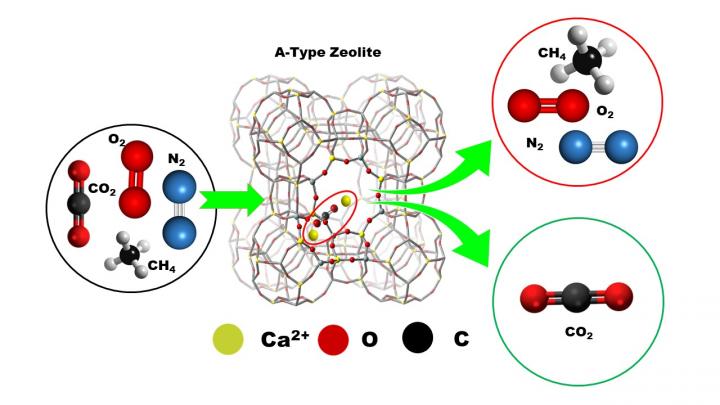Scientists report hitherto unobserved high-performance CO2 adsorption in zeolites at room temperature, opening doors to applications in air purification

Credit: 2021 Okayama University-InorgChem
It is now well known that carbon dioxide is the biggest contributor to climate change and originates primarily from burning of fossil fuels. While there are ongoing efforts around the world to end our dependence on fossil fuels as energy sources, the promise of green energy still lies in the future. Can something be done in the meantime to reduce the concentrations of CO2 in the atmosphere?
It would, in fact, be great if the CO2 in the atmosphere could simply be adsorbed! Turns out, this is exactly what direct air capture (DAC), or the capture of CO2 under ambient conditions, aims to do. However, no such material with the ability to adsorb CO2 efficiently under DAC conditions has so far been developed. “It is well known that CO2 is acidic in nature. Therefore, materials with basic nature are generally utilized as adsorbents for CO2. However, that often leads to corrosion of the system and is also not suitable for recycling the adsorbed CO2,” explains Professor Yasushige Kuroda from Okayama University, Japan, who conducts research on surface chemistry.
Against this backdrop, in a recent study published in the Journal of Materials Chemistry A, scientists from Okayama University and Japan Synchrotron Radiation Research Institute (JASRI) led by Prof. Kuroda explored the adsorption properties of a material that has so far remained an “underdog”: zeolites (minerals containing mainly aluminum and silicon oxides). “Zeolite materials have received little attention as adsorbents owing to their low CO2 adsorption capacity at room temperature and in the lower pressure adsorption region, as well as their poor selectivity over nitrogen,” says Prof. Kuroda.
In their study, Prof. Kuroda and his team designed an ion-exchanging method of zeolite with alkaline-earth ions and achieved a remarkably high CO2 adsorption under ambient conditions. The team specifically chose an A-type zeolite (silicon/aluminum ratio of 1) because of its appropriate pore size for adsorbing CO2, while the alkaline-earth ion exchange imparted a large electric field strength that, supposedly, acted as a driving force for the adsorption. Scientists chose a doubly charged calcium ion (Ca2+) as the exchange ion since it allowed for the greatest amount of adsorption. In fact, the adsorbed volume noted was the largest amount of CO2 to have ever been adsorbed by any zeolite system, surpassing that for other materials under similar conditions!
To investigate the underlying adsorption mechanism, the scientists carried out far-infrared (far-IR) measurements and backed them up with density functional theory (DFT) calculations. The far-IR spectra, which detected the vibrational modes due to Ca2+-zeolite vibration, showed a distinct shift towards longer wavelengths following CO2 adsorption, a feature scientists could not recognize in other samples, e.g. Na-ion exchanged A-type zeolite. They further verified their observation with a model that showed good agreement with DFT calculations.
Moreover, the scientists were able to completely desorb the adsorbed CO2 and recover the original sample and its specific adsorption properties. In addition, the sample showed a superior selective adsorption of CO2 from other gases after the scientists examined the separation of CO2 using a model gas that emulated ambient air in its composition.
The findings thus bring zeolites to the forefront as an efficient adsorbent of CO2 under ambient conditions, a feat previously thought unachievable with these systems. “Our work can open doors to potentially novel applications of zeolites, such as in the cleaning of air inside semi-closed spaces including space shuttles, submarines, and concert halls, and as an adsorbent material in the anesthetic process,” speculates Prof. Kuroda excitedly.
One thing is for sure, though: chemists will never look at zeolite in the same way again.
###
Media Contact
Yasushige Kuroda
[email protected]
Related Journal Article
http://dx.




